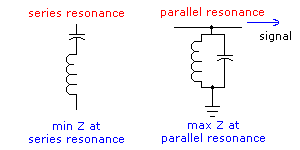|
|
|
MODULE V - FUNDAMENTALS OF ELECTRONICS
What is resonance? Resonance occurs when the reactance of an inductor balances the reactance of a capacitor at some given frequency. In such a resonant circuit where it is in series resonance, the current will be maximum and offering minimum impedance. In parallel resonant circuits the opposite is true. Resonance formula
The formula for resonance is:
2 * pi * f * L = 1 / (2 * pi * f * C) where: 2 * pi = 6.2832; f = frequency in hertz L = inductance in Henries and C = capacitance in Farads
Which leads us on to:
f = 1 / [2 * pi (sqrt LC)] where: 2 * pi = 6.2832; f = frequency in hertz L = inductance in Henries and C = capacitance in Farads |
|
|
|
Copyright �2000-2002 [email protected] -- All Rights Reserved -- Designed by WebCreations



